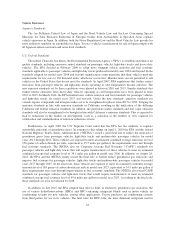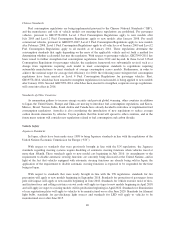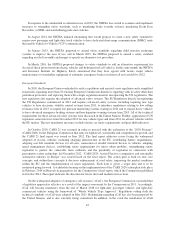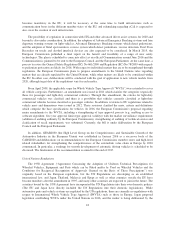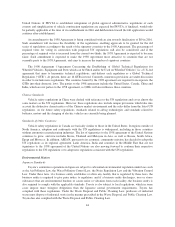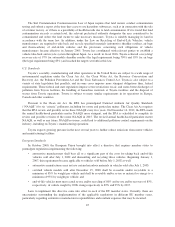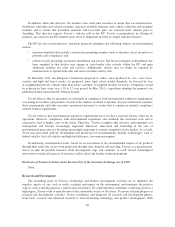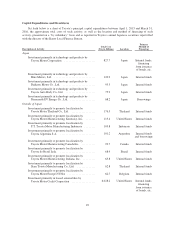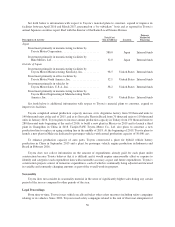Toyota 2015 Annual Report Download - page 46
Download and view the complete annual report
Please find page 46 of the 2015 Toyota annual report below. You can navigate through the pages in the report by either clicking on the pages listed below, or by using the keyword search tool below to find specific information within the annual report.With respect to standards that are scheduled to be newly brought in line with the UN regulations, safety
standards for hydrogen fuel cell vehicles will apply in stages to new models beginning in September 2018.
Standards for protection of passengers from full-wrap head-on collision will apply in stages to new models
beginning in September 2018. Standards for indirect visibility will apply to new models beginning in June 2019
and to existing models still in production beginning in June 2021.
Furthermore, unique to Japan, technical guidelines for remote-controlled parking assistance systems and
guidelines for response systems for driver emergencies have been created. The standardization of measures
relating to the quietness of hybrid vehicles, brake override systems, the strengthening of anti-spinal injury
measures and anti-drunk driving measures are currently under consideration.
U.S. Standards
The U.S. National Traffic and Motor Vehicle Safety Act of 1966, or Safety Act, requires vehicles and
equipment sold in the United States to meet various safety standards issued by the NHTSA. The Safety Act also
authorizes the NHTSA to investigate complaints relating to vehicle safety and to order manufacturers to recall
and repair vehicles found to have safety-related defects. The cost of these recalls can be substantial depending on
the nature of the repair and the number of vehicles affected.
The Transportation Recall Enhancement, Accountability and Documentation Act was enacted in the United
States on November 1, 2000. This Act required the NHTSA to regulate the dynamic rollover standards and to
upgrade federal motor vehicle safety standards relating to tires. It also required the NHTSA to enhance its
authority to gather information potentially relating to motor vehicle defects. This Act substantially increases the
maximum civil penalties for violation of regulatory requirements and specifies possible criminal penalties for
violations of the federal Fraud and False Statements Act. In 2003, the NHTSA expanded its New Car Assessment
Program (“NCAP”) to implement consumer information programs for vehicle rollover resistance and child
restraints and, beginning in 2003, adopted extensive early warning defect reporting requirements. Regulations
regarding tire-pressure monitoring systems were strengthened in 2005.
Legislation on a transportation budget plan promoting a safe and efficient vehicle safety program for
drivers, the Safe, Accountable, Flexible, Efficient Transportation Equity Act: A Legacy for Users
(SAFETEA-LU) was passed in August 2005. The legislation requires the NHTSA to propose and issue safety
standards to reduce rollover accidents, to complete the creation of standards for the reduction of vehicle
passengers released from cars at the time of rollover accidents, to upgrade door lock standards, to complete the
upgrade of roof crash standards, to decide on the side impact protection standards for passengers in all seat
locations, to review seat belt wearing technology and complete a study that includes a proposal for improving the
rate of seat belt usage, to establish standards to display NCAP ratings on new car labels and to complete the
upgrade of the standard for power windows that will require pulling up switches. Some actions have already been
taken and completed in response to the above requirements.
In February 2008, legislation to prevent non-traffic related injuries to young children caused by vehicles, the
“Cameron Gulbransen Kids Transportation Safety Act,” was passed. Pursuant to this legislation, the NHTSA
finalized standards requiring vehicles to be equipped with rearview camera systems in order to ensure rearward
visibility to prevent children from being struck by backing vehicles and mandating the use of brake shift
interlock systems.
In January 2011, legislation to improve the safety of the visually impaired and other pedestrians, the
“Pedestrian Safety Enhancement Act of 2010,” was passed. The legislation requires the NHTSA to draft and
finalize standards for warning sounds of electric and hybrid vehicles. The NHTSA formally proposed minimum
sound standards in January 2013, and the standards are currently in the regulatory review process.
41





